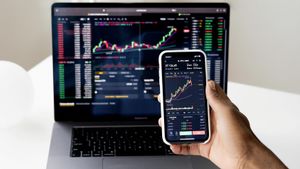JAKARTA - PT Bank Permata Tbk (PermataBank) reported that net profit after tax grew 64 percent compared to the previous year's (year-on-year/yoy) period to IDR 2 trillion, although faced with a slowdown in global economic growth and efforts to recover the Indonesian economy. This net profit growth was contributed from operating income of IDR 11.5 trillion or grew by 13.2 percent (yoy) supported by net interest revenue growth of 14.4 percent (yoy). in its official statement, quoted from Antara, Thursday 23 February, PermataBank President Director Meliza Rusli said that his party took advantage of the momentum-momentum in 2022 which strengthened PermataBank's position as one of the leading banks in Indonesia. Achievement in the digital realm, application of blockchain technology, support to the G20 Presidency through B20 activities, and integrated products and services provided encouragement for PermataBank to continue to provide the best for the company's stakeholders. "In 20 years of travel in the Indonesian banking arena, we will continue to be committed to serving customers and become a universal bank in providing products and services for various cross-generation segments," said Meliza.
He mentioned the synergy and continuous support of the controlling shareholder, namely Bangkok Bank Public Company Limited (PCL), maintaining PermataBank's position in the ranks of the 10 largest commercial banks in Indonesia. PermataBank recorded asset growth of 8.8 percent (yoy) to Rp255.1 trillion. Along with the national economic recovery, bank support in lending to the public grew 8.7 percent (yoy) to Rp136.3 trillion, mainly driven by corporate credit growth and home ownership loans (KPR) of 10.3 percent (yoy) and 12.6 percent (yoy), respectively. In terms of funding, customer deposits increased 8.8 percent (yoy) to Rp195.6 trillion, mainly contributed from demand and savings growth of 16.8 percent (yoy), in line with Bank's strategy to focus customer deposit growth at lower cost of funds to support lending with more competitive interest rates in the middle of the trend of increasing market interest rates. Efficient funding, according to Meliza, will strengthen Bank's position in channeling bank credit with competing interest rates. In line with this, the ratio of low-cost funds (Current Account Saving Account/CASA) banks increased to 58 percent, higher than the position at the end of December 2021 of 54 percent.
Even so, PermataBank continues to implement the precautionary principle in lending given considering the global economic slowdown accompanied by an increase in global interest rates and directly and indirectly can affect the risk of inherent credit. Thus, the gross non-performing loan ratio (NPL) was maintained at 3.1 percent in December 2022 or improved compared to the position at the end of December 2021 of 3.2 percent. The net NPL ratio that reflects the wisdom in the formation of credit loss reserves has also improved to 0.4 percent compared to 0.7 percent, where the coverage NPL ratio was maintained in the range of 240 percent.
In addition, the company continues to seek to resolve problematic loans through restructuring, litigation, and asset sales efforts.
In line with the decline in the NPL ratio, the risk credit ratio (Loan at Risk/LAR) also experienced a significant improvement from 14.6 percent in 2021 to 10.9 percent by the end of 2022.Bank always maintains and continues to improve asset quality, although banks have added revenue loss (clean) reserves of IDR 2.4 trillion during 2022 to ensure adequacy of reserves related to domestic and global economic conditions which are expected to still experience significant challenges in 2023. In the midst of rising inflation due to rising food and fuel prices, PermataBank has also managed to maintain a stable revenue cost ratio (Cost of Income Ratio/CIR) at a level of around 55 percent. Meanwhile, PermataBank's capital ratio is one of the strongest among the top 10 commercial banks, with a capital adequacy ratio (CAR) and a general equity level (Common Equity Tier/CET) 1 of 34.2 percent and 25.7 percent, respectively, where this becomes the capital for banks to accelerate business growth both organically and inorganically.
The English, Chinese, Japanese, Arabic, and French versions are automatically generated by the AI. So there may still be inaccuracies in translating, please always see Indonesian as our main language. (system supported by DigitalSiber.id)








